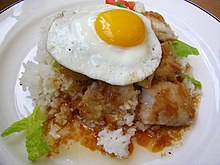
Spam is a brand of processed canned pork and ham made by Hormel Foods Corporation. It was introduced in 1937 and gained popularity worldwide after its use during World War II. By 2003, Spam was sold in 41 countries on six continents.

Donburi is a Japanese "rice-bowl dish" consisting of fish, meat, vegetables or other ingredients simmered together and served over rice. Donburi meals are usually served in oversized rice bowls which are also called donburi. If one needs to distinguish, the bowl is called donburi-bachi and the food is called donburi-mono.
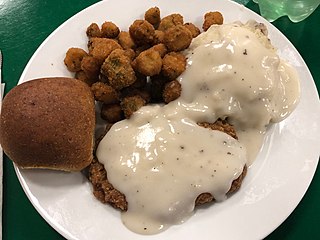
Chicken-fried steak, also known as country-fried steak, is an American breaded cutlet dish consisting of a piece of beefsteak coated with seasoned flour and either deep-fried or pan-fried. It is sometimes associated with the Southern cuisine of the United States. It is breaded and fried with a technique similar to the more common fried chicken, hence "chicken-fried". When deep-fried, it is usually referred to as "chicken-fried steak". Pan-fried versions are typically referred to as "country-fried steak".

Fried rice is a dish of cooked rice that has been stir-fried in a wok or a frying pan and is usually mixed with other ingredients such as eggs, vegetables, seafood, or meat. It is often eaten by itself or as an accompaniment to another dish. Fried rice is a popular component of East Asian, Southeast Asian and certain South Asian cuisines, as well as a staple national dish of Indonesia. As a homemade dish, fried rice is typically made with ingredients left over from other dishes, leading to countless variations. Fried rice first developed during the Sui Dynasty in China.

Saimin is a noodle soup dish common in the contemporary cuisine of Hawaii. Traditionally consisting of soft wheat egg noodles served in a hot dashi garnished with diced green onions and a thin slice of kamaboko, modern versions of saimin include additional toppings such as char siu, sliced Spam, sliced egg, bok choy, mushrooms, or shredded nori. When Chinese dumplings are added to the noodle soup, it is seen on menus as the heartier wonton min. All saimin establishments have their own, often secret recipe for the soup base, but primarily use kombu and dried shrimp as major ingredients. Common table condiments mixed in the saimin broth are Chinese hot mustard and soy sauce, added in small quantities according to each individual's taste. Many local residents of Hawaii also enjoy barbecued teriyaki beef sticks (skewers) or American hamburgers as a side dish.
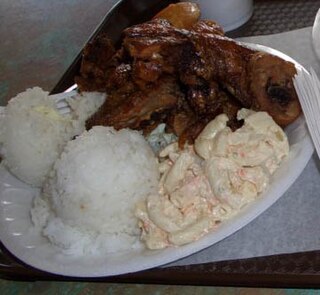
The plate lunch is a quintessentially Hawaiian meal, roughly analogous to Southern U.S. meat-and-threes. However, the combination of American and pan-Asian influence makes the plate lunch unique to Hawaii.

Egg foo young is an omelette dish found in Chinese cuisine. The name comes from the Cantonese language. Egg foo young is derived from fu yung egg slices, a mainland Chinese recipe from Guangdong.

The cuisine of Hawaii incorporates five distinct styles of food, reflecting the diverse food history of settlement and immigration in the Hawaiian Islands.
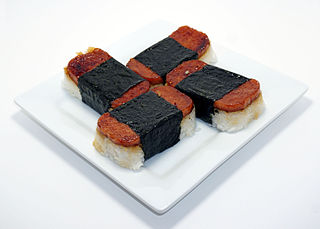
Spam musubi is a snack and lunch food composed of a slice of grilled Spam sandwiched either in between or on top of a block of rice, wrapped together with nori in the tradition of Japanese onigiri.

A slinger is an American Midwest diner specialty typically consisting of two eggs, hash browns, and a ground beef patty, all covered in chili con carne and generously topped with cheese and onions. The eggs can be any style. Hot sauce is usually served on the side. The slinger is considered to be a St. Louis late-night culinary original. It is described as "a hometown culinary invention: a mishmash of meat, hash-fried potatoes, eggs, and chili, sided with your choice of ham, sausage, bacon, hamburger patties, or an entire T-bone steak.

Parsi cuisine refers to the traditional cuisine of the Parsi people who had migrated into the Indian subcontinent from Persia, and currently spread across the modern-day South Asian republics of India and Pakistan.
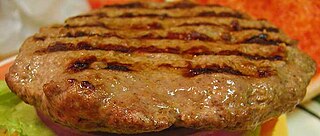
A patty or burger is a flattened, usually round, serving of ground meat or legumes, grains, vegetables, or meat alternatives. Patties are found in multiple cuisines throughout the world.
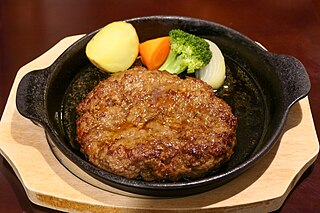
Hamburg steak is a patty of ground beef. Made popular worldwide by migrating Germans, it became a mainstream dish around the start of the 19th century. It is related to Salisbury steaks, which also use ground beef. It is considered the origin of the ubiquitous hamburger, when, in the early 20th century, vendors began selling the Hamburg steak as a sandwich between bread.

Cooked rice refers to rice that has been cooked either by steaming or boiling. The terms steamed rice or boiled rice are also commonly used. Any variant of Asian rice, African rice or wild rice, glutinous or non-glutinous, long-, medium-, or short-grain, of any colour, can be used. Rice for cooking can be whole grain or milled.

Huli-huli chicken is a grilled chicken dish in Hawaiian cuisine, prepared by barbecuing a chicken over mesquite wood, and basting it with a sweet huli-huli sauce.
Polynesian paralysis is a term describing the relaxed lifestyle in the Hawaiian islands and the spirit of aloha reflecting the love of the Hawaiian people. Far away from the haste, anxiety, and impatience that makes the rest of the world stressed and frantic, people in Hawaii live life a little slower and believe that they will get to where they need to go and do what needs to be done in good time. Visitors to the Hawaiian islands can fall in love with this more relaxed state of life and feel the effects of "Polynesian paralysis".

Okazuya or okazu-ya are a Japanese-style delicatessen common in Hawaii. Unlike western delicatessens found in North America or Europe, an okazuya is an establishment that sells readymade Japanese-styled food. "Okazu" refers to a side dish to accompany rice, while "ya" refers to a retail establishment.


